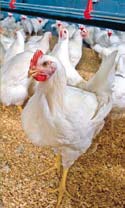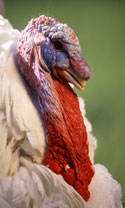



Poultry Carcass Disposal Options for Routine and Catastrophic Mortallity
The poultry industry has a number of options for the disposal of poultry carcasses from routine and catastrophic mortalities. ThePoultrySite editor, Jackie Linden, summarises a comprehensive report from the Council for Agricultural Science and Technology (CAST), which outlined the advantages an disadvantages of the different disposal methods.
"Among the most critical problems currently facing the poultry industry are those of waste management and associated environmental issues," wrote the members of the Council for Agricultural Science and Technology (CAST) in the introduction to their report entitled Poultry Carcass Disposal Options for Routine and Catastrophic Mortality.
Chair of the group was John P. Blake of Auburn University's Department of Poultry Science. He and fellow members of the Task Force point out that the increasing success and levels of production from the poultry industry has brought with it more mortality despite remarkable advances in our knowledge of the nutrition and health care of the birds.
"Carcass disposal is one of the major daily problems facing poultry meat and egg production facilities, posing a never-ending task as birds succumb to congenital defects, diseases, accidents, equipment failures and natural disasters," the authors say.
To illustrate the scale of the problem, they estimate that annual mortality in the US alone is in the region of 468 million broilers and 27 million turkeys, or 648,000 and 177,000 tonnes, respectively. This material must be disposed of in a safe and environmentally sound manner.
Practices for the Routine Disposal of Poultry Carcasses

- Burial currently is not permitted in some states, and its use will diminish with increased regulatory pressures and concerns for groundwater quality.
- Incineration is a biologically safe method but it tends to be slow and expensive and may create air quality issues.
- Composting serves as a suitable and innovative technique and has gained favour in areas where burial and incineration have become restricted.
- Removal of poultry carcasses from the farm and subsequent transport to a rendering facility offers great potential but the spread of pathogenic microorganisms during transport is a significant concern.
- Emerging methods for disposal of poultry carcasses — including acid or base preservation, lactic acid fermentation, and yeast fermentation — may be used for safe and realistic on-farm storage.
The report's authors say that these new methods offer the advantages of long-term stabilization of the carcasses and a dramatic decrease in the level of pathogenic microorganisms. These result in a transportable product that can be processed by a rendering facility into a suitable animal feed ingredient.
Alkaline hydrolysis, they add, is well adapted and serves as a premier choice for the treatment and elimination of highly infective wastes where it is the destruction of pathogenic microorganisms that is required rather than the preservation of carcass materials destined for rendering.
Disposal of Carcasses Following Catastrophic Events
Methods used for normal mortality losses have been adapted to deal with the large volume of carcasses that generally result from catastrophic events.
These adopted methods vary in their degree of success, cost or logistics, according to the CAST report.
The authors present case studies describing losses encountered from flooding, chemical residues, disease outbreaks and elevated temperatures as practical examples of catastrophic mortalities.
They found that the newer methods for catastrophic disposal offer little in technological advances and are based on refinements of existing methods, especially equipment improvements capable of dealing with large volumes of carcasses in a timely and efficient manner.
Carcass disposal should not be considered in isolation, it emerged. Equally important, are tools that will maximize emergency response efficiency include an early detection and warning system, a plan of action and contingency options.
* "Learning, planning, cooperation, implementation and evaluation are necessary keys to success." |
Looking to the future, the report's authors say there are opportunities to consider viable, environmentally friendly practices that may be used to benefit poultry carcass disposal in the future.
Recent improvements in incinerator technology have contributed to the development of more economical units that offer improved ease and efficiency of on-farm operation. Large portable incineration units may provide a suitable method for processing large volumes of birds in a biologically safe and equitable manner. Challenges remain in terms of the costs of operation, turnaround time and ash disposal.
Emerging methods such as pyrolysis and co-combustion are other alternatives that exhibit potential for development but the facilities necessary for these methods must be highly adaptive to deal with the flux in material availability and proximity to their supply source.
Composting - an environmentally and socially acceptable solution

Experience with composting poultry carcasses is well documented, and composting has proved very effective in dealing with carcasses that harbour infectious bacteria, viruses and fungi. Composting is has the benefits of being more environmentally and socially acceptable, biosecure, cost-effective and flexible implementation option than some of the alternatives.
For composting to be a successful mass mortality disposal option, however, it is essential that workers have the knowledge and skills to execute the fundamental procedures properly. Highly infectious diseases such as HPAI subtype H5N1 must be disposed of using an appropriately selected method, under the direction of well-trained professionals with regulated supervision.
Rendering is a logical approach when rendering facilities are available and willing to process the stabilized material in a timely, efficient manner.
The logistics of storage and transport to a rendering facility, however, offer challenges. Daily amounts of poultry mortality do not reach the level of volume that justifies pickup on a daily basis. Long-term on-farm storage during a typical grow-out cycle offers a sensible approach.
Some innovative methods may support long-term storage of poultry carcasses at the farm level, thereby lowering transportation costs to rendering and producing a usable protein by-product meal. Additional research and development in these areas will benefit producers and consumers in resolving issues on an international level.
Practical Conclusions for the Poultry Industry
* "All methods that allow for the environmentally safe disposal of poultry carcasses should be considered because no single method will solve all problems." |
Methods, strategies and practical applications presented in this paper offer a number of acceptable ways to dispose of poultry mortality. It appears that each method has its advantages and disadvantages, as well as costs and benefits.
The actual decision on which method is best should be based on individual farm circumstances and the restrictions that apply. It is crucial for emergency responders to develop a response plan based on the nature of the catastrophic event, the individual farm situation, local conditions and regulations because these factors will determine the applicability and feasibility of the carcass disposal method.
"All methods that allow for the environmentally safe disposal of poultry carcasses should be considered because no single method will solve all problems," the CAST report concludes.
CAST Issue Paper 40 Task Force Members authors were John P. Blake (Chair; Department of Poultry Science, Auburn University, Auburn, Alabama), John B. Carey (Department of Poultry Science, Texas A&M University, College Station), Aminul K.M. Haque (American Dehydrated Foods Inc., Verona, Missouri), George W. Malone (Department of Animal and Food Sciences, University of Delaware, Georgetown), Paul H. Patterson (Department of Poultry Science, The Pennsylvania State University, University Park), Nathaniel L. Tablante (Virginia-Maryland Regional College of Veterinary Medicine, University of Maryland, College Park) and Nickolas G. Zimmermann (Animal and Avian Sciences Department, University of Maryland, College Park).
Further Reading
| - | You can view the full CAST report by clicking here. |
October 2008








